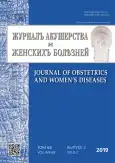Somatic features and reproduction characteristics of patients with perinatal fetal death
- Authors: Bezhenar V.F.1, Ivanova L.A.2, Frederiks E.V.2, Anashkina R.I.2
-
Affiliations:
- Academician I.P. Pavlov First St. Petersburg State Medical University
- Military Medical Academy named after S.M. Kirov
- Issue: Vol 68, No 2 (2019)
- Pages: 33-42
- Section: Original study articles
- URL: https://journals.rcsi.science/jowd/article/view/12945
- DOI: https://doi.org/10.17816/JOWD68233-42
- ID: 12945
Cite item
Full Text
Abstract
Aims of study. The current analysis was undertaken to determine risk factors for perinatal losses and assess the possibility of their prediction.
Study design, materials and methods. We analyzed 307 cases of perinatal death in obstetric facilities of the Leningrad region (main group). 357 women who gave birth to living children who lived 7 days of the perinatal period represented the control comparison group. A retrospective analysis was carried out based on medical hospital records: an examination of events during pregnancy, childbirth, postpartum, and early infancy, as well as afterbirth study findings and autopsy reports.
Results. We performed a retrospective analysis of the social (3 factors), somatic (28 factors), and reproductive (15 factors) statuses of patients with perinatal losses in order to try to assess the possibility of identifying risk groups and predicting perinatal and fetal mortality.
Conclusion. The predictors of perinatal mortality were determined, namely features of social status (absence of a marriage record and a permanent job, low level of education), somatic status (diabetes, cardiovascular pathology, arterial hypertension, chronic hemocontact infections), and reproductive status (late menarche, early sexual debut, previous infectious genital pathology, childbirth at a young age, etc.).
Full Text
##article.viewOnOriginalSite##About the authors
Vitaliy F. Bezhenar
Academician I.P. Pavlov First St. Petersburg State Medical University
Author for correspondence.
Email: bez-vitaly@yandex.ru
ORCID iD: 0000-0002-7807-4929
MD, PhD, DSci (Medicine), Professor, the Head of the Department of Obstetrics, Gynecology, and Reproductive Sciences
Russian Federation, Saint PetersburgLidia A. Ivanova
Military Medical Academy named after S.M. Kirov
Email: lida.ivanova@gmail.com
ORCID iD: 0000-0001-6823-3394
MD, PhD, Associate Professor. The Department of Obstetrics and Gynecology
Russian Federation, Saint PetersburgElena V. Frederiks
Military Medical Academy named after S.M. Kirov
Email: rd13@zdrav.spb.ru
MD, Assistant. The Department of Obstetrics and Gynecology
Russian Federation, Saint PetersburgRaisa I. Anashkina
Military Medical Academy named after S.M. Kirov
Email: rd13@zdrav.spb.ru
MD, Assistant. The Department of Obstetrics and Gynecology
Russian Federation, Saint PetersburgReferences
- legalacts.ru [интернет]. Министерство здравоохранения и социального развития Российской Федерации (Минздравсоцразвития России). Приказ от 27 декабря 2011 г. № 1687н «О медицинских критериях рождения, форме документа о рождении и порядке его выдачи» [доступ от 18.03.19]. Доступ по ссылке http://legalacts.ru/doc/prikaz-minzdravsotsrazvitija-rf-ot-27122011-n-1687n/ [legalacts.ru [Internet]. Ministerstva zdravookhraneniya i sotsial’nogo razvitiya Rossiyskoy Federatsii (Minzdravsotsrazvitiya Rossii). Prikaz ot 27 dekabrya 2011 g. No 1687n “O meditsinskikh kriteriyakh rozhdeniya, forme dokumenta o rozhdenii i poryadke ego vydachiˮ [cited 18.03.19]. Available from: http://legalacts.ru/doc/prikaz-minzdravsotsrazvitija-rf-ot-27122011-n-1687n/ (In Russ.)]
- Основы перинатологии / Под ред. Н.П. Шабалова, Ю.В. Цвелева. — М.: МЕДпресс-информ, 2004. — 576 с. [Osnovy perinatologii. Ed. by N.P. Shabalov, Y.V. Tsvelev. Moscow: MEDpress-inform; 2004. 576 p. (In Russ.)]
- Федеральная служба государственной статистики. Демографический ежегодник России. 2017. — М., 2017. — 265 с. [Federal’naya sluzhba gosudarstvennoy statistiki. Demograficheskiy ezhegodnik Rossii. 2017. Moscow; 2017. 265 p. (In Russ.)]
- Внутриутробное развитие человека / Под ред. А.П. Милованова, С.В. Савельева. — М.: МДВ, 2006. — 384 с. [Vnutriutrobnoe razvitie cheloveka. Ed. by A.P. Milovanov, S.V. Savel’ev. Moscow: MDV; 2006. 384 p. (In Russ.)]
- Врожденные и перинатальные инфекции: предупреждение, диагностика, лечение / Под ред. М.Л. Ньюэлла, Дж.Дж. Мак-Интайра. — СПб., 2004. — 439 с. [Vrozhdennye i perinatal’nye infektsii: preduprezhdenie, diagnostika, lechenie. Ed. by M.L. Newell, J.J. MсIntayr. Saint Petersburg; 2004. 439 p. (In Russ.)]
- Кулаков В.И., Орджоникидзе Н.В., Тютюник В.Л. Плацентарная недостаточность и инфекция. — М., 2004. — 494 с. [Kulakov VI, Ordzhonikidze NV, Tyutyunik VL. Platsentarnaya nedostatochnost’ i infektsiya. Moscow; 2004. 494 p. (In Russ.)]
- Фролова О.Г., Токова З.З. Основные показатели деятельности акушерско-гинекологической службы и репродуктивное здоровье // Акушерство и гинекология. — 2005. – № 1. — С. 3–6. [Frolova OG, Tokova ZZ. Main indices of the activity of obstetric-and-gynecological service and reproductive health. Akush Ginekol (Mosk). 2005;(1):3-6. (In Russ.)]
Supplementary files










